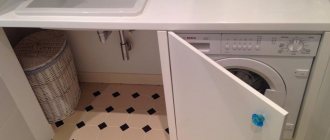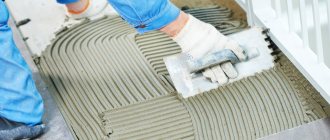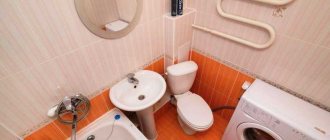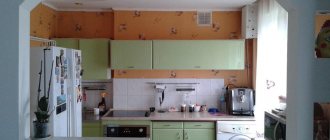Installing a washing machine (WM) in the kitchen is often a necessary measure, because... there was simply no room for it in the small bathroom. And sometimes such an arrangement is a deliberate step, if it is convenient to place all the equipment in a house or apartment in one place.
There were other advantages
:
- additional work surface. As a rule, SM is installed under a countertop on which you can cook;
- a small bathroom without a machine will become free and convenient to use.
Washing machine in the kitchen, built into the end of the kitchen unit
. Of the minuses:
- the need for camouflage (especially in kitchens with a classic design, where SM does not fit at all);
- proximity of washing powder to food;
- the need to carry dirty laundry to the kitchen every time you wash;
- the need to select and prepare a place for installation in advance.
Kitchen with built-in SM under the countertop
Despite all the listed inconveniences, the housewife will eventually get used to this arrangement. Important questions remain: how to integrate a washing machine into a kitchen unit so that it does not violate the stylistic unity, and its use is comfortable. We'll talk about this in more detail later.
Features of accommodation
The main reason why they decide to install a unit in the kitchen is to free up space in the bathroom.
There are a number of other positive aspects:
- Safety. There is much less humidity in the kitchen than in the bathroom;
- Aesthetic appearance. Kitchen appliances can be hidden behind furniture fronts. Then the laundry intended for washing will not be visible. Even when the machine door is slightly open after the washing process, no one will see it. Everything will be hidden behind facades;
- Possibility of installing large-sized machines. Not every bathroom can accommodate such a model, but its placement in the kitchen is possible. What is the advantage of such a model? Washing in it is carried out more efficiently, in addition, the large drum of the unit allows you to accommodate a large volume of laundry.
- In addition, the models are characterized by increased stability due to the installed counterweight at the bottom of the unit. This also results in less vibration and noise.
There are also disadvantages to a kitchen with a washing machine. There are not many of them, but they are available:
The system for washing textiles does not fit well into the interior. Groceries, unwashed laundry, and a slightly open door do not make the interior immaculate.
You can get rid of these unpleasant moments if you carefully think through the future facade and make convenient niches for storage.
Advantages
The most important advantage: the bathroom does not take up precious space, and it becomes freer. But besides this, there are several more advantages that you don’t immediately think about.
Safety
According to fire safety rules, electrical appliances should not be placed in rooms with high humidity, which is the bathroom. The kitchen is a different matter, here the humidity is much lower, and most often there is a window that provides active air circulation.
Work zone
Usually the washing machine is hidden behind the facade or simply covered with a countertop. In both cases, a new work surface appears, which will never be superfluous in the kitchen.
Communications
It is convenient to install the washing machine in the kitchen, since the main communications are already there: both water supply and sewerage - there is no need to install anything additional. You just have to clarify how to connect the electrical wiring, because the machine requires a dedicated line.
Wash anytime
You can do laundry in the kitchen at any time, regardless of whether anyone is taking a bath. On the other hand, noise during spinning and draining can interfere with an evening family meal or watching TV.
But, according to reviews, the same hood is louder than a washing machine. You can run the wash at night: this way the machine will not disturb anyone, and your energy bills will be lower.
Built-in options
There are many ways to integrate a machine into the kitchen. A considerable part of them involve maintaining the integrity of the style and camouflaging the washing machine. Before purchasing household appliances, it is recommended to remove the parameters so that the machine fits the prepared niche.
There are both standard and unusual placement techniques. For example, a washing machine in the kitchen under the countertop.
When choosing a suitable location, it is important to consider three factors:
- Distance from the stove, refrigerator, and dishwasher. The vibration of these household appliances contributes to the failure of the fans and compressors built into the unit.
- Providing space for filling and unloading washed items from the machine (at least 1 sq.m.).
- Free access to hoses for maintenance or repair.
Design of a small kitchen with a washing machine
More and more often you can find kitchens in which washing machines are located. This can be explained extremely simply - in most apartments there is not much space allocated for bathrooms, much less for utility and household spaces. Consequently, there is nowhere else to put the washing machine. Very often, placing appliances in the kitchen turns out to be the only way out, because few people will decide to consider giving up this element of household appliances, especially if there are small children in the family.
Washing machine under the bar counter in the kitchen with a corner unit
Successful color combination of the washing machine with the facades of the kitchen unit
A silver model of a washing machine will look good under a gray countertop set
At the beginning of this material, the advantages and disadvantages of such a solution were already discussed. However, it is important to understand that when it comes to a small space, many of the disadvantages become even more significant. However, if this is the only way of arrangement, then you can turn a blind eye to them, or level them out with the help of a well-thought-out furniture layout.
Full embedding
At the stage of creating a kitchen unit project, you should consider the type of built-in option. It is necessary to measure the dimensions of the equipment, and take them into account when drawing up the design of the headset. Full integration means that the equipment is hidden behind furniture facades.
This technique is typical for models with a standard side hatch. In the photo of the washing machine in the kitchen you can see different options for fully integrating the equipment.
Built-in washing machines
There are several ways to embed the SM. The choice of one option or another will depend not only on visual preferences and aesthetic considerations, but also on the layout, size of the cabinet and the dimensions of the machine itself.
If you are still at the stage of purchasing a washing machine for a ready-made set, then your task is greatly simplified. Modern manufacturers offer SMs of different sizes.
Built-in model SM, hidden behind the facade
You can choose a model according to the dimensions that fit perfectly into a cabinet prepared for CM or into a niche under a tabletop.
There are SMs on sale with the following parameters:
- width – from 45 to 70 cm;
- height – from 50 to high 130 cm;
- depth – from 33 to 85 cm.
If you have already purchased a full-size machine, but do not yet have a kitchen set, then there are only two possible solutions:
Below are several possible solutions from which you will surely choose the best one for your kitchen.
Complete installation under the countertop
Similar to any other built-in appliances, the front part of such a machine will be equipped with special hinges for attaching the facades of the headset.
Its parameters of depth, width and height are already initially precisely set to the standard parameters of lower cabinets.
The disadvantage of such a built-in washing machine is the high price and difficult access to the body in case of breakdown.
Installation in a cabinet behind the facade
To build a washing machine into a cabinet, it is necessary that the dimensions of the equipment itself and the cabinet allow it to be placed there. All three parameters are fundamentally important here - height, width and depth.
The standard height of a base cabinet is 80-85 cm, and a full-size SM is 85 cm. If you have not yet purchased equipment, then in the store you should pay attention to compact models with a height of up to 70 cm or with the ability to remove the top cover. It is possible that in the car you have already purchased, it is possible to unscrew the top part, thereby making its height smaller.
This may also be interesting: Small dishwashers built under the sink.
The floor cabinet from most manufacturers can have several width parameters suitable for installing a SM in it: 60 and 80 cm. Consequently, the width of the machine will be several centimeters smaller. It is important to take into account here that on the left between the machine and the furniture body it is advisable to leave a gap the width of the cabinet door hinge. This must be done so that the powder compartment can move forward freely.
The standard depth of a kitchen cabinet is 60 cm. When choosing a machine that is supposed to be hidden behind a cabinet door, we take into account not only the depth of the cabinet, but also measure the parameter along with the door to its very convex point. In this way, it is possible to embed SM with a depth of up to 50-55 cm.
Also make sure that the bottom of the cabinet can support the weight of the machine. Otherwise, the bottom of the cabinet needs to be strengthened. The furniture itself must also be stable enough to withstand vibrations from equipment.
If you have already purchased a washing machine and have problems installing it due to its dimensions, then the optimal solution is to make custom-made furniture to meet the specified parameters.
Despite all its installation complexity, a built-in washing machine in the kitchen has an undoubted advantage - complete camouflage of the washing machine in the interior and preservation of stylistic unity.
Installation in a niche between cabinets, without a door
The space specially prepared for SM probably already has the required height, depth and width. This method is simpler and therefore the most common.
Most machines, as a rule, already have the required width and depth, matching the standard dimensions of the cabinet.
Washing machine in a small kitchen
The question of how to hide a washing machine in the kitchen with this installation option can be approached in several ways, depending on the style of the interior:
- choose SM and headsets in the same color scheme. Although the choice of colors for the washing machine is small, you can easily find a universal and most common white option to match the white set. You can also more often find gray or black SM models. Another idea is to paint or cover the body of the car with vinyl stickers in the desired color.
- choose the SM in the same style as the rest of the kitchen appliances (oven, microwave, etc.), for example, metallic. This option will look good in modern styles - high-tech, loft, American, etc.
- close with a beautiful curtain. The idea is relevant for styles in a rustic spirit (country, Provence, shabby chic).
- make an accent.
There are unusual and bright designer cars that can become a color accent in the interior. Here it is important to support their design in other interior elements. For example, decorate the apron in the same color.
Stationary location
If there is no other place to install the washing machine in the kitchen, then the only possible solution is to place the equipment separately from the unit. Even with this arrangement, you can hide or harmoniously fit into the interior a free-standing SM:
- under the dining table;
- behind a screen or curtain.
It is desirable that with this installation method, the equipment should have very compact dimensions, which is especially important for a small kitchen.
The disadvantage of this location is the problematic connection to communications.
Positioning the Top Loading Machine
Such SMs are very compact and are easier to place permanently than front-loading models. But they are not as practical in terms of using the kitchen workspace if they need to be built in.
They can be built under a folding table top or a wide bar counter.
Placement in a cabinet
A common way of arranging a kitchen set is to divide it into two parts, where wall cabinets, a stove, and a countertop are included in the first part, and the second independent part includes a cabinet with a sink and a machine, placed along the side wall.
This arrangement contributes to the convenience of connecting the unit and a long service life.
Technical details of the process
The connection for all installation options follows approximately the same algorithm, no matter whether you decide to install the unit in a bathroom cabinet or in a kitchen unit, under a countertop or under a sink. In any case, you should proceed step by step:
- Consider how to connect to the water supply.
- Create a drain for used water.
- Make electrical wiring (it is advisable to install a moisture-resistant socket).
- Make sure that all specified communications can be connected to the machine.
- Check the length of the hoses and power cord so that the device can be conveniently pulled out of the niche in which it is placed.
- Connect the unit to the water supply and sewer pipes.
- Push the machine into the designated place and secure the legs.
When installing a washing machine under a countertop, you must carefully calculate the dimensions of the future niche. There should be a gap of 3-5 cm between the unit and the walls of the furniture so that unnecessary noise does not occur during vibration.
Built-in appliances can be an attractive design element in a kitchen or bathroom. If you show maximum imagination, you will be able to turn the disadvantages of the room into advantages, and the result of the work performed will pleasantly surprise you.
Under the table top
It is popular to integrate a washing machine into a so-called “pocket”. In other words, this is an equipped part of the area for placing the unit under the countertop, which is fixed on both sides.
The advantage of this technique is that it does not require fundamental changes in furniture. If desired, the machine can be easily moved and then put back in its original place. Having chosen this option, there is no need to place the machine in the center of the kitchen, which is very important when planning.
Placement of a top-loading machine
A similar model can be placed permanently, built under a folding tabletop, or put away in a closet.
In the first case, the appearance of the device may negatively affect the interior; in the second, it will not always be convenient to use. When located in a closet, it is necessary to leave space on top for comfortable loading and unloading.
The photo shows a built-in top-loading machine
Washing machine plus refrigerator
Arranging all your preferred equipment in a small space while observing safety rules is a real challenge. The main thing is to think through all the options for kitchen design with a washing machine and refrigerator. In dead-end situations, it is better to use design services.
Kitchen interior planning begins with the refrigerator, as the most massive object. The refrigerator is usually placed in a corner or at the entrance to the kitchen area.
When installing, you must adhere to the following recommendations:
- There should be a distance of 50 cm between the “work triangle”, which consists of a refrigerator, stove and sink;
- The refrigerator must not be installed next to heating appliances;
- When installing the refrigerator, it is important to leave a distance of 2-5 cm.
There is no categorical prohibition on placing a refrigerator next to a washing machine. In this case, the danger is posed by the increased humidity of the unit, but with professional installation, possible problems can be avoided.
A kind of column will help to place a lot of household appliances in the kitchen with a refrigerator and washing machine. It is a pencil case made of several drawers, adapted for installing electrical appliances. A high cabinet can be installed next to the refrigerator.
The most suitable solution for a compact kitchen would be to place a refrigerator in a column next to the washing machine. This design “goes” all the way to the ceiling and makes it possible to rationally use empty space.
Manufacturers of modern household appliances greatly simplify the task for owners of small apartments. In stores you can buy models of different sizes. Furniture makers also help by making custom-made perfect sets according to the customer’s measurements.
Thanks to this, placing a refrigerator and washing machine in a small space will not be a problem.
Where is the best place to place the machine?
The main requirements for installing a washing machine are: proximity to communications (water supply and sewerage), the presence of a grounded outlet and a flat floor surface.
The photo shows a washing machine and dishwasher at the sink
To avoid regretting the transfer, follow the rules:
- do not allow the washing machine to be close to other household appliances: vibration is harmful to the refrigerator and oven;
- Never install the machine under the hob - high temperatures will damage its plastic parts;
- placing a washing machine and a dishwasher next to each other is possible if there is a gap between them and vibration during spinning will not be transmitted to the dishwasher;
- water and sewer hoses should be no more than 2.5-3 meters in length, this will reduce the possibility of leaks and blockages in them;
- when placing the washing machine inside the box, it is necessary to leave a gap of 2 cm on each side to take into account vibration;
- take care to install a base that is easy to remove so that you can get to the drain filter if necessary.
Advantages and disadvantages of installation
Will the washing machine be in the way in the kitchen? It's difficult to give a definite answer. For some, this arrangement is not a hindrance, but for other people it is unacceptable. And in most cases, the kitchen area plays a huge role. Therefore, it is worth considering in detail the positive and negative aspects when installing a machine in the kitchen. Let's start with the advantages:
- You don't have to install the machine in the bathroom, which means there will be much more space there.
- You can perform several actions at the same time. The washing is going on, and you are cooking. In this case, you don’t have to drop everything and run to the bathroom to monitor the washing process.
- Due to the fact that there is more space in the kitchen, you can without a doubt purchase a full-sized washing machine. The space in some bathrooms does not allow for a large and capacious machine.
Flaws:
- It is unlikely that you will be throwing dirty laundry around in the kitchen. You can install a special basket for this in the bathroom. In the kitchen there is nowhere to place a linen drawer or basket.
- There is also no place to store household chemicals in the kitchen. Moreover, storing powders near food is a risky business. This means you have to run to the bathroom before every wash.
- Kitchen appliances can often get dirty. Therefore, the occurrence of greasy stains and drips is normal.
- Difficulties may arise when installing vertical type washing machines. You will have to order a cabinet with a folding tabletop - this is very inconvenient.
You see that there are more minuses than pluses, but this should not scare you. For example, a separate niche in the kitchen unit is suitable for storing washing detergents and a basket with dirty laundry. The same applies to stains that occur during cooking. If the niche is covered with doors, nothing will get on the body of the machine.
Recommendation! Installing a washing machine in the kitchen will significantly save space in the bathroom. Have you dreamed of a Jacuzzi or a large shower? Send SM to the kitchen and the bath is yours.
From an engineer's point of view
In the process of connecting an automatic washing machine, the following engineering systems are important:
- water pipes;
- sewerage;
- power supply
In order for the device to operate efficiently and economically, it is necessary to provide a supply of cold water that meets all quality standards. Used water must be discharged to the sewer. Electricity is supplied from a reliable source of sufficient (with a small margin) power.
For stable and durable operation, tap water with the lowest hardness level is ideal. If your water has doubts regarding such qualities as hardness and purity, then before entering it into the washing machine it is recommended to install appropriate filters, which must be periodically replaced as they become dirty.
The sewer system of an apartment building fully meets the requirements for organizing the drainage of waste water. In private buildings there are also no problems, provided that standard pipelines and shaped fittings are used.
Electrical connections must be made without the use of extension cords, low-quality connectors and non-standard parts. It is better if the power cable is connected to the nearest outlet with a grounding conductor and a residual current device (RCD) on the line.











